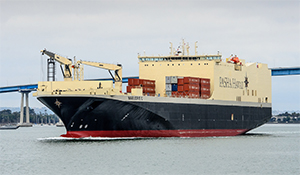Pasha Hawaii is joining the move to liquefied natural gas to transport cargo, announcing plans late last year to build two LNG-powered containerships for the Jones Act trade between the islands and the West Coast.
Each of the dual-fuel ships will be 3,400 TEU, with the capacity to handle 500 45-foot containers and 400 refrigerated containers. They will operate fully on LNG “from day one in service,” the Honolulu-based carrier said in a November news release. Delivery of the first ship is expected in mid-2019 and the second in early 2020.
Just who will provide the vessels was uncertain as Professional Mariner went to press. In the news release, Pasha said it was considering a pair of U.S. shipyards to build the vessels, with the option to order two more. Contract specifications were expected by the end of November and the selection of the builder was anticipated in January.
Pasha spokeswoman Emily Sinclair said in mid-January that the company could not provide further details about the ships and which yard would build them until the end of the first quarter. The release states that the vessels will feature “a state-of-the-art engine, an optimized hull form, and an underwater propulsion system with a high-efficiency rudder and propeller.”
Pasha’s venture into LNG for the Jones Act trade follows similar projects by TOTE Maritime, Crowley Maritime and Matson. TOTE was the first to put an LNG-powered cargo ship into U.S. service, taking delivery of the 764-foot, 3,100-TEU Isla Bella in October 2015. It was followed by its Marlin-class sister, Perla del Caribe, in January 2016. Both ships were built by General Dynamics NASSCO in San Diego and operate between Jacksonville, Fla., and Puerto Rico.
Crowley is making a push into LNG propulsion with a pair of container/roll-on, roll-off ships (con-ros) currently being built at VT Halter Marine in Pascagoula, Miss. The Commitment-class ships, El Coqui and Taino, will have the capacity for 2,400 TEU and nearly 400 vehicles. Both vessels are slated for the Puerto Rico trade. El Coqui is set for launch in early 2017, with Taino following at an unspecified date.
Matson’s dual-fuel initiative involves four containerships: two under contract with NASSCO and two being built by Philly Shipyard, formerly Aker Philadelphia. The Kanaloa-class ships to be built at NASSCO, Lurline and Matsonia, will be 870 feet long and have the capacity for 3,500 TEU. Construction is set to begin in early 2018, with deliveries in 2019 and mid-2020. Two other containerships for the Hawaii-to-mainland trade are on the books for Matson at Philly. The 850-foot Aloha-class vessels will be able to handle 3,600 TEU. Delivery of the first ship is planned for the third quarter of 2018 and the second ship in the first quarter of 2019.
Dual-fuel capability means the ships will not have to operate on LNG all of the time, providing options when it comes to the availability of bunkering and the price of LNG compared to conventional fuel. Regardless of market swings, Pasha said LNG will deliver when it comes to exhaust emissions, cutting sulfur oxides by 95 percent, nitrogen oxides by 90 percent, carbon dioxide by 25 percent and particulate matter by nearly 100 percent.
Now it comes down to who gets the work. The latest additions to Pasha’s cargo fleet — the 579-foot Jean Anne and the 692-foot Marjorie C, delivered in 2005 and 2015, respectively — were built by VT Halter.
“We are fortunate to have shipyards within the United States that are very capable of building best-in-class cargo ships, including LNG-powered vessels, competitively,” said George Pasha IV, president and CEO of The Pasha Group.

